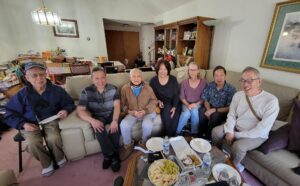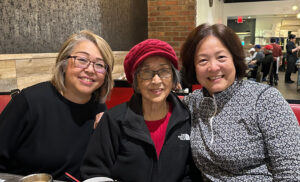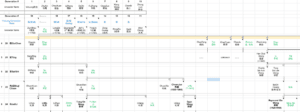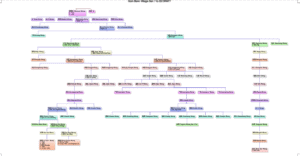Want to trace your ancestry? Map your family tree?
Until recently, that was especially difficult for us American-Born Chinese. Most of us can’t match our ancestors’ American names with their Chinese names. And even if we could go back in our history a couple of generations, we couldn’t go back very far.
Genealogy Help
Now that’s changed. Late last year, Chi Tung (董小琪), an experienced bilingual Chinese-American genealogist, came to us, offering to help.
She quickly mapped 20 family trees of Gom Benn Wongs. And she developed a list of 154 “Wongs” – in both English and Chinese – from names mentioned on our website (gombenn.org) and in the old Voice of Gom Benn newsletters. This was that key generation that founded the Gom Benn Village Society in Los Angeles after leaving China and starting new lives in America.
Chi Tung’s family trees are highly detailed, spanning a dozen generations and more. For each family branch, there maybe dozens and even hundreds of names. The spreadsheets are too big for us to easily post to our website. Attached is an example, with many wings cut off so we could post just a portion of this family tree. Read more on these spreadsheets at the end of this article.
Connecting the Names
From Chi Tung’s list of Gom Benn names, she has identified 116 in the YinLong Wong Genealogy (published in 2013 in the town of DongKou, next to Gom Benn Village). Her research clearly establishes their lineage back to roots in Gom Benn Village (or Gan Bian Cun in Mandarin PinYin), Taisan City, Canton Province (GuangDong), China.
Many from her list were officers of Gom Benn Village Society during the 25 most active years (1974-2000). According to Chi Tung, 77 officers of GBVS were found in the YinLong Genealogy, while another 19 officers’ lineage remains uncertain. These results came mainly from research into the historical articles on the Gom Benn website, 25 years of Voice of Gom Benn (1974-2000) newsletters, help from archeologist Laura Ng and her research, and from her friend Peter Lau and others.
Collaboration

She isn’t our only family tree sleuth. Brian Wong has researched extensively his ancestors including his father Ging Ching Wong, and grandfather Chang Wing Wong – one of the founders of the Ying Chong Lung grocery on San Pedro Street in Los Angeles.
Now what do we do with their findings?
First, we need to bridge the gap between the English and Chinese names – a gap between West and East, America and China. There seem to be inaccuracies in the genealogy books. Because many of our Gom Benn ancestors came to America as paper sons or daughters, they may have used multiple names.
Bilingual Key
Chi Tung is in a unique position to help bridge this name gap, since she is fluent in both Chinese and English. Chi has tried to match them up with the Chinese-only names in two genealogy books that go back 850 years. Sometimes she’s successfully matching up names. Sometimes not. Which is why she’s reached out to individual families – for help filling in the gaps.
Why? All of us within the Gom Benn family know we are connected. Tracing our family roots back through the generations can help us connect to other branches of our family, and give us a deeper sense of who we are, where we came from, what they did, the trials they overcame, the accomplishments they achieved, and the dreams they had.
Now What?
What’s next? What will we do with Chi’s research, with her family trees? Eventually, we want to share them so we can all easily see our connections. How is to be determined.
For the sake of our privacy, we won’t be sharing family trees on our website with information on the latest generations, those still alive – unless families choose to.
Families are encouraged to contact us at scholarship@gombenn.org for Chi’s research on their families. Chi welcomes questions sent directly to her email: hchitung@yahoo.com.
Hopefully you can help us fill in the gaps. So we can better understand our roots.
As Chi noted, in China there is a saying “may our ancestor protect us 愿老祖宗保佑.”
If we don’t even know who our ancestors are, and pay our respect to them, how can they know to protect us? Chi asked. We are researching our family trees for this generation, and for future generations who want to learn about their roots and their ancestors.








Pingback: Who Is Chi Tung? - Gom Benn Scholarship Fund